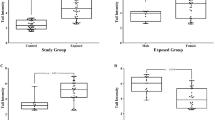Abstract
Objectives: Many antineoplastic drugs were found to have carcinogenic, mutagenic and teratogenic potential. The aim of this study was to carry out cytogenetic and internal dose monitoring of hospital pharmacy personnel regularly involved in the preparation of cytostatic agents, in order to test possible cytostatics-induced genotoxic effects due to occupational exposure under routine working conditions, and in cases of accidental contamination. Methods: Platinum in whole blood and anthracyclines in plasma were measured to assess internal exposure to cytostatics. The level of cytogenetic damage was determined in peripheral blood lymphocytes with the micronucleus test and the sister chromatid exchange assay. Five series of monitoring were performed over a period of 2 years. Results: No significant differences in the mean frequencies of sister chromatid exchanges (SCE) and micronuclei (MN) were found between occupationally exposed probands and controls (9.9 ± 1.4 vs 10.1 ± 1.2 SCEs/cell and 21.2 ± 7.2 vs 23.3 ± 7.5 MN/2000 binucleated (BN) cells, n=16). Significant elevations of SCE or MN were detected in seven out of 12 cases of accidental contamination at the workplace, whereas no increase in platinum in blood and anthracyclines in plasma was observed in these probands. Two cases of non-reported contamination were identified by measurement of epirubicin in plasma. Smoking was found to increase the SCE significantly. No correlation between individual SCE scores and MN scores was observed. Conclusions: Our findings support a transient increase in SCE or MN after relevant exposure to cytostatic drugs in cases of accidental contamination. The lack of significant differences in SCE and MN between hospital pharmacy personnel and unexposed controls, points to high standards of safety at the corresponding workplaces.
Similar content being viewed by others
Author information
Authors and Affiliations
Additional information
Received: 11 October 1999 / Accepted: 25 April 2000
Rights and permissions
About this article
Cite this article
Pilger, A., Köhler, I., Stettner, H. et al. Long-term monitoring of sister chromatid exchanges and micronucleus frequencies in pharmacy personnel occupationally exposed to cytostatic drugs. Int Arch Occup Environ Health 73, 442–448 (2000). https://doi.org/10.1007/s004200000164
Issue Date:
DOI: https://doi.org/10.1007/s004200000164




